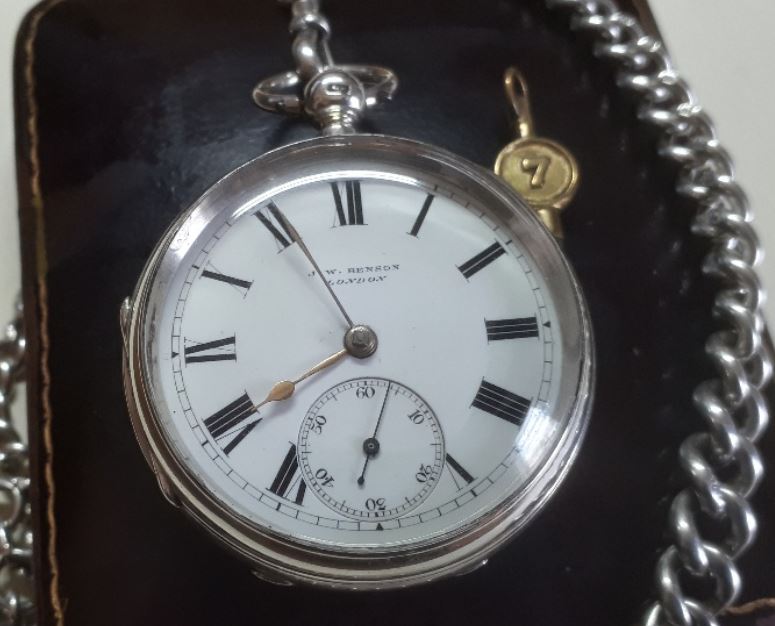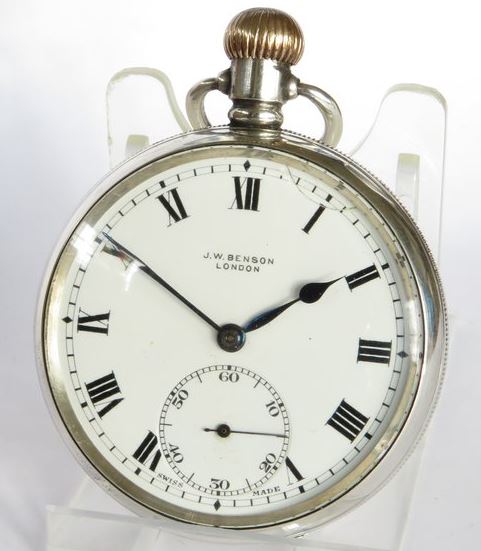J W Benson was founded by two brothers, James William Benson and Samuel Suckley Benson in 1847. They promoted themselves as watchmakers, gold and silversmiths of Cornhill in the City of London. In addition to retailing their own watches and jewellery, they were also importers and retailers dealing in fine gemstones and precious metals. After just eight years, the partnership was dissolved in 1855 and J.W. Benson carried on alone. Benson was regarded as one of Victorian London’s most prestigious retail jewellers and he also retailed his own watch movements. His business expanded over the years and he added additional premises in Ludgate Hill (1854-1937), Old Bond Street (1872-3), and Royal Exchange (1892-1937). The company flourished and proudly boasted an elite client base made up of both British and European royalty, celebrities and wealthy industrialists and businessmen. Benson was also listed as an official watchmaker to the Admiralty & the War Department.
By the 1860s he was advertising his range of pocket watches and clocks, but also watch repair services. He began to participate in both national and international expositions including London in 1862, Paris in 1867 and the Inventions Exhibition of 1885 at which he unveiled the ‘Patent Dust and Damp Excluding Band for Watches’.
Royal warrants
In 1878 J.W. Benson died leaving his sons Alfred and Arthur to continue the business. The following year they were awarded a Royal Warrant by Queen Victoria to which they would later add those of the Prince of Wales and the Kings of Siam and Denmark. Whilst best known for their timepieces, in the 1880’s J W Benson started expanding their range to include jewellery. The collection included pieces such as brooches, bracelets, diamond pendants and cufflinks.
The rest of the 19th century was a period of gradual, but steady growth. J W Benson acquired their much-admired competitors Hunt & Roskell and Sir John Bennett, which brought them an influx of high society customers. In 1892 J. W. Benson became a limited company and moved to a new “steam” factory at 38 Belle Sauvage Yard. It is unlikely that Benson’s was manufacturing their movements, but quite possible that they were assembling or finishing blank movements supplied by other watchmakers.
World Wars
During World War I, along with its competitors, J W Benson embraced the newly introduced trench watch as the traditional pocket watch was not practical in the trenches. Up until this time, the company was still “manufacturing” (assembling) its own movements. At this point, things become a little unclear. Some sources state that the factory at Belle Sauvage Yard was hit during a bombing raid in 1914. Other, more reputable sources, suggest that the factory was bombed in 1941 during World War II. Either way, sometime during the first half of the 20th century J W Benson lost the ability to assemble or “manufacture” their movements. As a result, J W Benson was forced to purchase movements from a number of producers in Switzerland, including, most notably, Longines, Cyma and Revue. Additionally, all written records were destroyed in the bombing.
Further research suggests that the World War II date is more likely. The Zeppelin bombing raids on London didn’t start until 1915. There is also evidence that Benson was using Swiss made movements well before the factory was destroyed. I recently had a J W Benson pocket watch pass through my hands with a 15-jewel Swiss made movement that was hallmarked to 1912. Obviously, Benson must have been using Swiss made movements long before the factory was destroyed. I suspect this was an economic decision due to the efficiency of the Swiss watchmaking process. There is some doubt that Benson ever “manufactured” watches, this may have been a marketing ploy. It could be that their “factories” were simply involved in finishing blank movements supplied by the likes of P. & A. Guye or Nicole, Nielsen & Co.
I spent a considerable amount of time reviewing online sales archives for J W Benson watches. I looked at over a hundred J W Benson sales from the early 1900s to the 1930s. It became very clear that Benson was almost exclusively using Swiss movements from c1910. These were 15-jewel movements from either Cyma or Revue. Whether they were importing the movements as completed watches or assembling the watches themselves from ébauches is unclear. I suspect that J W Benson couldn’t compete on quality and price against his Swiss counterparts. This is likely due to the changes in the watchmaking industry in Switzerland after they adopted the Swiss Made brand. They changed their focus from producing high volumes of cheap watches to making high-quality timepieces to protect their brand.
Retail
After World War II J W Benson continued as a high street retailer for many years, with adverts from the late 1950s showing a wide range of quality watches and jewellery. J W Benson continued in retail until 1973 when the brand was sold to the Royal jewellers, Garrards. Furthermore, the name was acquired by Mappin and Webb in the 1990s. It’s no longer clear where the brand now resides.
Related content
Read about other Manufacturers and Makers.
British Museum – J W Benson Ltd.

